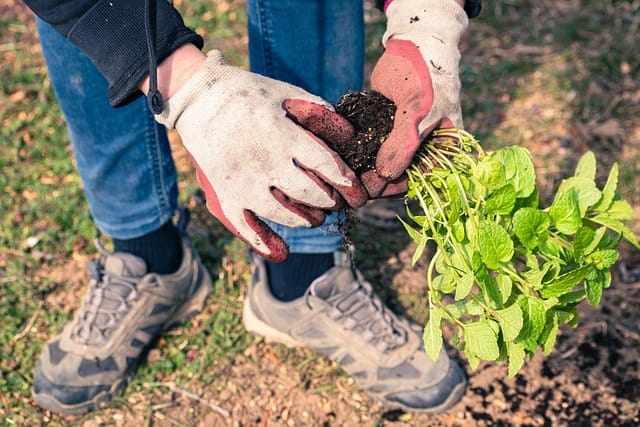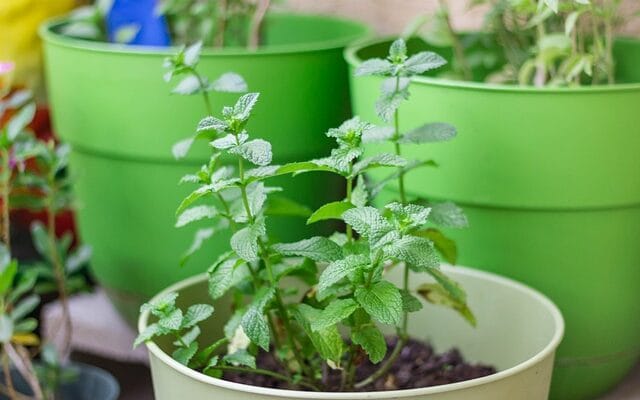Disclosure: This post may contain affiliate links, meaning we get a commission if you decide to make a purchase through our links, at no cost to you. See our full disclosure here.
Herbs! Those fragrant, flavorful wonders can transform any dish from bland to grand. They’re like the rock stars of the garden, adding zest and zing to our culinary creations. But have you ever contemplated homegrown herbs? It’s easier than you might think, and the rewards are oh-so-delicious.


What do you think – would an herb rockband look more like the option on the right or on the left?
Imagine entering your garden and being greeted by a symphony of fragrant herbs. Sights, smells, textures, tastes, and sounds transport you from the ordinary to the extraordinary in your backyard herb oasis.
Welcome to the world of growing herbs at home, where beauty, fragrance, and culinary delight intertwine. This beginner’s guide takes you on a delightful journey, from planting the seed to enjoying fresh herbs from your flourishing garden. Whether you’re a seasoned gardener or a complete novice, you’ll discover the ease and satisfaction of growing these versatile plants. Get ready to transform your garden into a source of nutritious foods and herbs and elevate your culinary creations with the freshest flavors imaginable. Let’s dive in and discover the magic of growing herbs at home!
Types of Herbs
Before we discuss the practical aspects of planting and maintaining an herb garden, let’s review the two categories of herbs: annuals and perennials.

Annuals
Think of annuals as the party animals of the herb world. They live fast, die young, and leave behind a beautiful legacy of flavor. These herbs complete their life cycle in a single season, going from seed to flower to seed again in months. Popular annuals include basil, dill, cilantro, and summer savory.
Perennials
Perennial herbs are the gift that keeps on giving. They return yearly, providing a continuous supply of fresh herbs for culinary adventures. These hardy plants can withstand even harsh winters, making them a splendid choice for novice and experienced gardeners. Popular perennial herbs include chives, mint, oregano, rosemary, sage, and thyme.
Planting Your Herbs
Now that you’re familiar with the different types of herbs, let’s explore the various methods for starting your herb garden.
Direct Sowing
Direct sowing is the simplest method. You sow seeds directly into the soil where you want them to grow. It’s an excellent choice for beginners and works well for herbs that don’t like to be transplanted, such as dill, cilantro, and chives.
Transplants
If you’re looking for a head start on the growing season or want to grow herbs that are a bit more finicky, transplants are the way to go. Transplants are young plants that have been started indoors or in a greenhouse and are planted in your garden once the weather warms up. This method works well for herbs like basil, rosemary, and oregano.
Cuttings
Another method for propagating herbs is through cuttings. This involves taking a small piece of stem from an existing plant and helping it to grow roots. It’s a great way to expand your herb collection or share your favorite herbs with friends.
The best planting method for you will depend on the type of herb you’re growing, your climate, and your personal preferences. Experiment with different techniques and see what works best for you.

Timing and Spacing
Proper timing and adequate spacing are essential factors when planting herbs. The table below provides specific planting times and spacing recommendations for various herbs.
| Herb | Planting Time | Spacing |
| Basil | After the last frost | 12 inches apart |
| Chives | Early spring or fall | 6 inches apart |
| Cilantro | Early spring or fall | 6 inches apart |
| Dill | Early spring or fall | 12 inches apart |
| Mint | Early spring or fall | 12 inches apart |
| Oregano | Early spring or fall | 12 inches apart |
| Parsley | Early spring or fall | 12 inches apart |
| Rosemary | After the last frost | 18 inches apart |
| Sage | After the last frost | 18 inches apart |
| Thyme | After the last frost | 12 inches apart |
Herbs do not have to be grown in nice rows all lined up like little soldiers. Mix and match them to give your herb garden its own unique beauty. Spiral herb gardens are quite beautiful. Just make a small mound maybe three or feet round, and plant the herbs in a spiral pattern, working their way down the mound. Place a tall flowering herb at the top as a centerpiece. It is a beautiful and efficient use of space and can supply herbs for all your needs.
Maintaining Your Herb Garden
Once your herbs are planted, it’s time to take care of them. Fortunately, herbs only need basic care and won’t destroy your schedule with maintenance chores. It really can be as simple as water, weed, fertilize, and harvest.
Watering
Water is essential for plant growth, and herbs are no exception. Water your herbs regularly, especially during hot, dry weather. However, be careful not to over-water, as this can lead to root rot and other problems. A rule of thumb is to water your herbs when the top inch of soil feels dry.
Weeding
Weeds are the bane of any gardener’s existence, and they can quickly take over your herb garden if left unchecked. Weed your herbs regularly, especially when they’re young and vulnerable. You can weed by hand or use a hoe or other gardening tool to make the job easier. Weed when your soil is wet and they pop out much easier.
Soil Health and Fertilization
Healthy soil is the foundation of any thriving garden, and herbs are no exception. Ensure your herbs are planted in well-drained, fertile soil rich in organic matter. You can amend your soil with compost or other organic matter to improve health and fertility. We have some great recommendations for amendments here.
Harvesting and Using Your Herbs
The best time to harvest your herbs is in the morning after the dew has dried but before the sun gets too hot. This is when the essential oils that give herbs their flavor are at their peak. You can harvest herbs by snipping off individual leaves or sprigs or cutting back whole stems. Harvest and either use them or preserve them as soon as possible. This will help them maintain their freshness and vitality.
Using Fresh Herbs
Fresh herbs are a culinary delight, adding vibrant flavors and aromas to your dishes. You can use fresh herbs in many ways, from adding them to salads and soups to infusing them in oils and vinegar. They are also a beautiful garnish for any dish.
Preserving Herbs
If you have more herbs than you can use fresh, you can preserve them for later use by drying or freezing. To dry herbs, hang them upside down in a cool, dark, dry place. Once the herbs are dry and crumbly, store them in airtight containers. To freeze herbs, chop them finely and place them in airtight containers or freezer bags.
Troubleshooting Common Problems
Even with the best care, your herbs may encounter some problems. Here are a few common issues and how to troubleshoot them.
Pests
Pests can be a nuisance in any garden, and herbs are no exception. Some common herb pests include aphids, spider mites, and whiteflies. You can control these pests by handpicking them off the plants or using organic pest control methods like insecticidal soap or neem oil.

Diseases
Diseases can also affect herbs, primarily if grown in less-than-ideal conditions. Some common herb diseases include powdery mildew, downy mildew, and root rot. You can prevent these diseases by ensuring good air circulation, avoiding over-watering, and planting disease-resistant varieties.
Conclusion: Growing Herbs at Home is Easy and Tasty
Growing your own herbs is a rewarding experience that will bring you years of enjoyment. Not only will you have a constant supply of fresh, flavorful herbs for your culinary creations, but you’ll also have the satisfaction of knowing you grew them yourself.
So, what are you waiting for? Get out there and start growing herbs at home! You’ll be amazed at how easy and enjoyable it is. And who knows, you might even discover a new favorite herb.
Disclaimer: This post is for informational purposes only and should not be construed as health, wellness or nutrition advice. Please see our full disclaimers here.


Leave a Reply